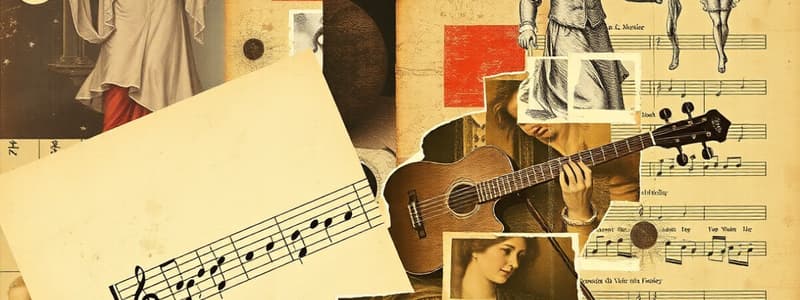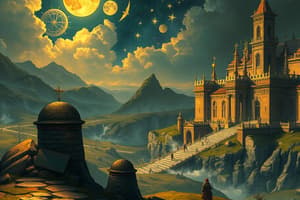Podcast
Questions and Answers
What significant change in music notation occurred around 1030?
What significant change in music notation occurred around 1030?
- Guido d'Arezzo developed the four-line musical staff. (correct)
- The printing press enabled wider distribution of sheet music.
- The invention of the harpsichord allowed for more complex compositions.
- Polyphony was introduced, leading to richer harmonies.
How did the Renaissance period (mid-15th century) impact music?
How did the Renaissance period (mid-15th century) impact music?
- The birth of opera marked a shift towards dramatic storytelling.
- The first orchestras were formed, leading to larger-scale works.
- The patronage system increased and music became a commodity. (correct)
- Plainchant singing became less complex during this time.
What distinguishes medieval church music (6th-11th centuries)?
What distinguishes medieval church music (6th-11th centuries)?
- The introduction of monody with a basso continuo accompaniment.
- The widespread use of madrigals in religious services.
- The incorporation of word painting techniques to enhance emotional expression.
- The shift away from plainchant towards multi-voiced organ-like compositions. (correct)
Which instrumental developments are associated with the Renaissance?
Which instrumental developments are associated with the Renaissance?
What characterized polyphony in choral sacred music?
What characterized polyphony in choral sacred music?
How did Catholic and Protestant composers' approaches to sacred music differ?
How did Catholic and Protestant composers' approaches to sacred music differ?
What are madrigals, and what technique did composers like Marenzio and Weelkes employ in their creation?
What are madrigals, and what technique did composers like Marenzio and Weelkes employ in their creation?
Who is considered a key figure in the transition to the Baroque style, and what innovation did they introduce?
Who is considered a key figure in the transition to the Baroque style, and what innovation did they introduce?
What is monody, and how does it relate to basso continuo?
What is monody, and how does it relate to basso continuo?
Which statement best describes the overall shift in musical style from the medieval and Renaissance periods to the Baroque?
Which statement best describes the overall shift in musical style from the medieval and Renaissance periods to the Baroque?
Flashcards
Baroque Era
Baroque Era
A period from 1600-1750 marked by dramatic music and opera's birth.
Music Staff
Music Staff
A system of lines and spaces created by Guido d'Arezzo for musical notation.
Polyphony
Polyphony
A musical texture combining multiple independent vocal parts.
Madrigals
Madrigals
Signup and view all the flashcards
Monody
Monody
Signup and view all the flashcards
Choral Sacred Music
Choral Sacred Music
Signup and view all the flashcards
Word Painting
Word Painting
Signup and view all the flashcards
Instrumental Music Growth
Instrumental Music Growth
Signup and view all the flashcards
Renaissance Music
Renaissance Music
Signup and view all the flashcards
Claudio Monteverdi
Claudio Monteverdi
Signup and view all the flashcards
Study Notes
Baroque Music (1600-1750)
- The Baroque era marked significant developments in European music, including the birth of opera, growth of the orchestra, and increased instrumental music.
- The style shifted away from the intricate music of the medieval and Renaissance periods, becoming more dramatic.
Medieval and Renaissance Music (6th-16th Centuries)
- From the 6th to 11th centuries, medieval church music transitioned from plainchant to a greater number of voice parts.
- The Renaissance period brought great cultural shifts across Europe.
- Polyphony (different melodic lines sung simultaneously) developed in the 12th-16th centuries, with composers like Léonin, Pérotin, Guillaume Dufay, Josquin des Prez, Giovanni Palestrina, and Orlande de Lassus.
- Musical notation and the music staff were developed by Guido d'Arezzo around 1030.
Development of Vocal Music
- Around 1030, Guido d'Arezzo created the music staff, allowing clearer musical notation and interpretation .
- From simple melodies in the early periods, music evolved to involve multiple instrumental parts and various vocal parts, particularly in the Renaissance and Baroque eras.
17th Century Music
- The Italian composer Claudio Monteverdi significantly influenced the start of the Baroque period in the 17th century, particularly with his use of opera and monody.
- Monody featured one primary vocal part supported by an instrumental accompaniment, known as basso continuo.
Madrigals and Choral Music
- Madrigals were popular non-religious songs for several voices, often characterized by word painting.
- Polyphonic music (multiple melodic lines) became important during the centuries.
- Catholic composers like Giovanni Gabrieli wrote elaborate masses while composers like Thomas Tallis explored more repetitive, simpler anthems.
Instrumental Music
- Numerous instruments, such as viols, sackbuts, recorders, virginal, and harpsichord, developed or became refined during the Renaissance and Baroque.
Studying That Suits You
Use AI to generate personalized quizzes and flashcards to suit your learning preferences.




